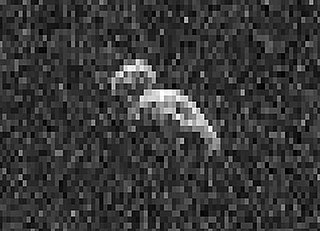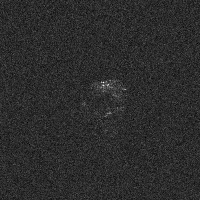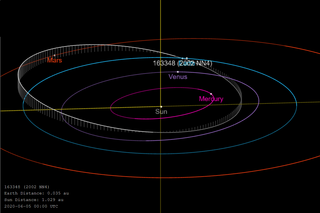Related Research Articles
2340 Hathor, provisional designation 1976 UA, is an eccentric stony asteroid, classified as near-Earth object and potentially hazardous asteroid. It belongs to the Aten group of asteroids and measures approximately 210 meters in diameter. Discovered by Charles Kowal in 1976, it was later named after the ancient Egyptian goddess Hathor.
(12538) 1998 OH is a stony asteroid, classified as near-Earth object and potentially hazardous asteroid of the Apollo group, approximately 1.8 kilometers in diameter. It was discovered on 19 July 1998, by astronomers of the Near-Earth Asteroid Tracking program at the Haleakala Observatory in Hawaii, United States. This minor planet was numbered by the Minor Planet Center on 23 November 1999. As of 2018, it has not been named. In 2019, the asteroid came within about 73 lunar distances of Earth.
4450 Pan is a highly eccentric asteroid and contact binary, classified as a potentially hazardous asteroid and near-Earth object of the Apollo group, approximately 1.1 kilometers in diameter. It was discovered on 25 September 1987, by American astronomers Eugene and Carolyn Shoemaker at Palomar Observatory in California, United States. It was named after Pan from Greek mythology.
1864 Daedalus, provisional designation 1971 FA, is a stony asteroid and near-Earth object of the Apollo group, approximately 3 kilometers in diameter. It was discovered on 24 March 1971, by Dutch–American astronomer Tom Gehrels at Palomar Observatory, California, and named after Daedalus from Greek mythology.
8013 Gordonmoore, provisional designation 1990 KA, is an eccentric, stony asteroid and near-Earth object of the Apollo group, approximately 1–2 kilometers in diameter.
4055 Magellan, provisional designation 1985 DO2, is a bright asteroid and near-Earth object of the Amor group. It is approximately 2.5 kilometers in diameter, and its orbit is moderately eccentric. It was discovered on 24 February 1985, by American astronomer Eleanor Helin at Palomar Observatory in California, United States. It was later named for Portuguese explorer Ferdinand Magellan.
5426 Sharp, provisional designation 1985 DD, is a bright Hungaria asteroid and suspected binary system from the inner regions of the asteroid belt, approximately 2–3 kilometers in diameter. It was discovered on 16 February 1985, by American astronomer Carolyn Shoemaker at Palomar Observatory, California, and named after American geologist Robert P. Sharp.
For other uses, see Steel (disambiguation).
(5646) 1990 TR is a probable rare-type binary asteroid classified as near-Earth object of the Amor group, approximately 2.3 kilometers in diameter. It was discovered on 11 October 1990, by Japanese astronomers Seiji Ueda and Hiroshi Kaneda at Kushiro Observatory near Kushiro, in eastern Hokkaido, Japan.
(416151) 2002 RQ25 is a carbonaceous asteroid of the Apollo group, classified as near-Earth object and potentially hazardous asteroid, approximately 0.2 kilometers in diameter. It was discovered on 3 September 2002, by the Campo Imperatore Near-Earth Object Survey (CINEOS) at the Italian Campo Imperatore Observatory, located in the Abruzzo region, east of Rome.
(374158) 2004 UL is a sub-kilometer asteroid on an outstandingly eccentric orbit, classified as near-Earth object and potentially hazardous asteroid of the Apollo group. The object is known for having the second-smallest perihelion of any known asteroid, after (137924) 2000 BD19.

(388188) 2006 DP14, provisional designation 2006 DP14, is a sub-kilometer sized, peanut-shaped asteroid on a highly eccentric orbit, classified as near-Earth object and potentially hazardous asteroid of the Apollo group. This contact binary was discovered on 23 February 2006, by astronomers of the LINEAR program at the Lincoln Laboratory's Experimental Test Site near Socorro, New Mexico, in the United States. On 10 February 2014, it passed 6.25 lunar distances from Earth. The asteroid is approximately 400 meters in diameter and has a rotation period of 5.77 hours.

(436724) 2011 UW158, provisionally known as 2011 UW158, is a stony, walnut-shaped asteroid and fast rotator, classified as near-Earth object and potentially hazardous asteroid of the Apollo group, approximately 300 meters in diameter. It was discovered on 25 October 2011, by Pan-STARRS at Haleakala Observatory on the island of Maui, Hawaii, in the United States.

(190166) 2005 UP156 is a stony asteroid and binary system, classified as near-Earth object of the Apollo group, approximately 1 kilometer in diameter. It was discovered on 31 October 2005, by astronomers of the Spacewatch survey at the Kitt Peak National Observatory in Arizona, United States. Its minor-planet moon with an orbital period of 40.25 hours was discovered in 2017.
(90075) 2002 VU94 (provisional designation 2002 VU94) is an asteroid on an eccentric orbit, classified as near-Earth object and potentially hazardous asteroid of the Apollo group, approximately 2.5 kilometers in diameter. It was discovered on 13 November 2002, by astronomers of the Near-Earth Asteroid Tracking program at Palomar Observatory in California, United States. It is one of the largest potentially hazardous asteroids known.
(159857) 2004 LJ1, provisional designation 2004 LJ1, is an asteroid on an eccentric orbit, classified as near-Earth object and potentially hazardous asteroid of the Apollo group, approximately 3 kilometers in diameter. The asteroid was discovered on 10 June 2004, by astronomers of the LINEAR program at Lincoln Laboratory's Experimental Test Site near Socorro, New Mexico, in the United States. It is one of the largest potentially hazardous asteroids known to exist.
(85713) 1998 SS49 (provisional designation 1998 SS49) is an asteroid on an eccentric orbit, classified as near-Earth object and potentially hazardous asteroid of the Apollo group, approximately 3 kilometers (1.9 miles) in diameter. The asteroid was discovered on 29 September 1998, by astronomers of the LINEAR program at Lincoln Laboratory's Experimental Test Site near Socorro, New Mexico, in the United States. It is one of the largest potentially hazardous asteroids and has a notably low Earth-MOID of less than the distance to the Moon.
(385343) 2002 LV, provisional designation 2002 LV, is a stony asteroid on a highly eccentric orbit, classified as near-Earth object and potentially hazardous asteroid of the Apollo group, approximately 1.5 kilometers in diameter. It was discovered on 1 June 2002, by astronomers with the Lincoln Near-Earth Asteroid Research at the Lincoln Laboratory's Experimental Test Site near Socorro, New Mexico, in the United States. The Sr-type asteroid has a rotation period of 6.2 hours and is likely elongated.
(172034) 2001 WR1, provisional designation: 2001 WR1, is a sub-kilometer near-Earth object of the Amor group, approximately 650 meters (2,100 feet) in diameter. The S-type asteroid has been identified as a potential flyby target of the Hayabusa2 mission. It was discovered on 17 November 2001, by astronomers with the Lincoln Near-Earth Asteroid Research at the Lincoln Laboratory's Experimental Test Site near Socorro, New Mexico, in the United States. The asteroid has a rotation period of 8.0 hours and possibly an elongated shape. It remains unnamed since its numbering in December 2007.

(163348) 2002 NN4 (prov. designation:2002 NN4) is a dark, sub-kilometer near-Earth object and potentially hazardous asteroid of the Aten group that flew by Earth on 6 June 2020. The highly elongated X-type asteroid has a rotation period of 14.5 hours and measures approximately 0.7 kilometers (0.4 miles) in diameter. It was discovered by LINEAR at the Lincoln Laboratory's Experimental Test Site in New Mexico on 9 July 2002.
References
- 1 2 3 4 5 6 "JPL Small-Body Database Browser: 4401 Aditi (1985 TB)" (2015-05-10 last obs.). Jet Propulsion Laboratory . Retrieved 20 June 2017.
- 1 2 3 4 "4401 Aditi (1985 TB)". Minor Planet Center. Retrieved 4 June 2016.
- 1 2 3 Schmadel, Lutz D. (2007). "(4401) Aditi". Dictionary of Minor Planet Names – (4401) Aditi. Springer Berlin Heidelberg. p. 378. doi:10.1007/978-3-540-29925-7_4351. ISBN 978-3-540-00238-3.
- 1 2 3 4 Mainzer, A.; Grav, T.; Masiero, J.; Bauer, J.; Cutri, R. M.; McMillan, R. S.; et al. (November 2012). "Physical Parameters of Asteroids Estimated from the WISE 3-Band Data and NEOWISE Post-Cryogenic Survey". The Astrophysical Journal Letters. 760 (1): 6. arXiv: 1210.0502 . Bibcode:2012ApJ...760L..12M. doi:10.1088/2041-8205/760/1/L12. S2CID 41459166 . Retrieved 1 February 2016.
- 1 2 3 4 5 "LCDB Data for (4401) Aditi". Asteroid Lightcurve Database (LCDB). Retrieved 4 June 2016.
- 1 2 Warner, Brian D. (July 2015). "Near-Earth Asteroid Lightcurve Analysis at CS3-Palmer Divide Station: 2015 January - March". The Minor Planet Bulletin. 42 (3): 172–183. Bibcode:2015MPBu...42..172W. ISSN 1052-8091. PMC 7244166 . PMID 32455355 . Retrieved 1 February 2016.
- 1 2 Warner, Brian D. (January 2015). "Near-Earth Asteroid Lightcurve Analysis at CS3-Palmer Divide Station: 2014 June-October". The Minor Planet Bulletin. 42 (1): 41–53. Bibcode:2015MPBu...42...41W. ISSN 1052-8091. PMC 7249511 . PMID 32457969 . Retrieved 1 February 2016.
- 1 2 Behrend, Raoul. "Asteroids and comets rotation curves – (4401) Aditi". Geneva Observatory . Retrieved 4 June 2016.
- ↑ "MPC/MPO/MPS Archive". Minor Planet Center. Retrieved 4 June 2016.